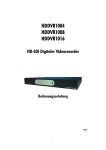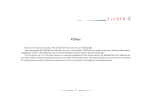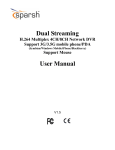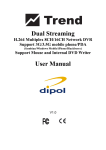Download User's Manual - X-Core Technology Co., Ltd.
Transcript
User’s Manual V 0.96 1 Regulatory Information FCC compliance: This equipment has been tested and found to comply with the limits for a digital device, pursuant to part 15 of the FCC Rules. These limits are designed to provide reasonable protection against harmful interference when the equipment is operated in a commercial environment. This equipment generates, uses, and can radiate radio frequency energy and, if not installed and used in accordance with the instruction manual, may cause harmful interference to radio communications. Operation of this equipment in a residential area is likely to cause harmful interference in which case the user will be required to correct the interference at his own expense. FCC Conditions This device complies with part 15 of the FCC Rules. Operation is subject to the following two conditions: 1. This device may not cause harmful interference. 2. This device must accept any interference received, including interference that may cause undesired operation. Attention! This is a class A product which may cause radio interference in domestic environment; in this case, the user may be urged to take adequate measures. Safety Precautions ˙To reduce risk of fire or electric shock, do not expose this appliance to rain or moisture. ˙Do not place the appliance near to heaters, other heat sources or under direct solar irradiation. ˙Make sure the ventilation slot on the appliance is not covered during operating. ˙To prevent risk of electric shock, connect only to a proper earth grounded outlet. Do not operate appliance with other none specified power supplies. ˙Do not attempt to modify or use the supplied AC power cord if it is not the exact type and rating required. ˙Do not attempt to disassemble the appliance. Contact qualified service personnel for maintenance. ˙Handle the appliance with care. Do not strike or shake, which may damage the appliance. Notice ˙Information in this document is subject to change without notice. 2 Table of Contents 1 Introduction 6 1.1 Features 6 1.2 Product Specification 7 1.3 Front Panel 8 1.4 Rear Panel 9 1.5 Remote Control (Optional) 10 1.6 Packing Detail and Installation 11 2 General Operation 14 2.1 Login 14 2.2 Live Viewing 16 2.2.1 Basic Operation 16 2.3 Search and Playback Operation 18 2.3.1 Basic operation 18 2.3.2 Calendar 19 2.3.3 Search operation 19 2.3.4 Playback operation 21 3 PTZ Control 22 4 Export Video 23 5 Export Player 24 5.1 Installation 24 5.2 Starting the Program 24 6 System Setup Menu 27 6.1 Camera 27 3 6.1.1 Settings 27 6.1.2 Record Settings 34 6.1.3 Schedule Settings 35 6.2 Network 36 6.2.1 Network Settings 36 6.2.2 Notification 38 6.3.1 Alarm Input Settings 40 6.3.2 Exception Management 41 6.4 System Settings 42 6.4.1 Device Setting 42 6.4.2 User Settings 42 6.4.3 Date/Time Settings 43 6.4.4 Display 45 6.4.5 Disk 47 6.4.6 Miscellaneous 48 6.4.7 Configuration 50 6.5 Information 51 6.5.1 General Information 51 6.5.2 Log 51 7 Web Viewer Operation 52 7.1 Connecting to DVR 52 7.2 Login 52 7.3 Remote Live View 54 7.4 Remote Search and Playback 56 7.4.1 Search by Time 56 7.4.2 Search by Channel 56 7.4.3 Search by Event 57 4 7.4.4 Web Viewer Playback Operation 58 7.4.5 Web Viewer Setup Menu 59 7.4.6 Remote Export 60 7.4.7 Remote PTZ Control 61 8 VS Viewer for iOS and Android 62 8.1 Android System 62 8.2 iOS System 66 5 1 Introduction The 4channel HD-SDI DVR transmits the uncompressed Full HD (1080P) video image over coaxial cables. It performs the high definition image with zero loss and low latency of image data when viewing the video. The DVR provides the easy-to-install benefit that allows users to view the HD megapixel image without requiring having the complicated knowledge of IP based system. It is the ultimate solution for high-quality and reliable surveillance system. 1.1 Features Dual-Core CPU demonstrates the extreme and industry-leading performance in recording, playback and networking. Support 4CH 1080p30 real time recording and 4CH simultaneous real time playback. High-Speed Gigabit network interface. Support dual streaming. Remote access through Web, CMS, Mobile App (Android & iOS). Easy archive via USB, CD/DVD-RW or network. 6 1.2 Product Specification System Operating System Embedded Linux Operations Live, Recording,Playback,Backup & Remote access Control Mode USB mouse, IR remote control, Webpage Video Compression 4x1080p30 H.264 HP/MP/BP (with dual streams) Audio Input 4 x RCA Output 1 x RCA 2-way Audio Support Display Display mode Full screen/Multi-screen/PIP/Sequence Output 1x HDMI(1920x1080p60),1xVGA(up to 1920x1080, 60Hz) Sequence Support OSD GUI Recording Recording Mode Continuous,scheduled, alarm, motion Recording Capability Up to120 fps at Full HD(1920x1080) Pre Recording 5 seconds Post Recording 300 or above seconds Playback & Backup Display mode Full screen/Multi-screen Playback control Play/Pause/Step/Fast forward/Rewind/Fast rewind Search Control By Date/Time,Alarm search Export Through USB/Webpage Mobile Viewing on Smartphone/Tablet PC Yes ; iOS, Android Internal Storage 2xHDD, 1xDVD(optional) External Storage e-SATAx1 Network Support TCP/IP,SMTP,DHCP,DDNS,PPPoE,UDP,SSL,RTP,RTSP,NTP Ethernet 1x10/100/1000Mbps I/O USB 2; 1 for mouse control and 1 for backup Alarm 4 Alarm in/ 1 Alarm out RS485 1; Support Pelco D, Pelco P Security Watermark Yes User Privilege 3 Levels of User Access Support Environm ental Power 12VDC input Temperature 0°C ~ 40°C Weight 2.5Kg 7 1.3 Front Panel The front panel includes: 1 2 4 3 1. IR receiver – Receiver for IR remote. 2. Power button – Power On/Off DVR. 3. Status indicators – ˙Power : Indicator turns on when DVR power on. ˙REC : Indicator turns on when DVR is recording. ˙HDD : Indicator turns on when system is accessing hard disk. ˙LAN : Indicator turns on when network access is connected. ˙Alarm : Indicator turns on when alarm is detected. ˙Status : Indicator turns on when system exception alert is detected, such as disk full, disk error, no disk, network disconnect, illegal login, disk over temperature, fan fail, network fail, power loss and IP conflict. ˙CH1~CH4 : Indicators turn on when the video is connected to the system. 4. USB port – USB port for connecting devices, such as USB mouse or USB flash device. 8 1.4 Rear Panel The rear panel connectors are: (1) Power: Plug the DV12V power source into the power socket. (2) Audio Out: Connect a speaker or other audio output device to the audio output connector. (3) Audio In: Connect the microphone or camera audio output to the audio input connectors. (4) SDI In: Connect HD-SDI camera’s video output to the SDI video input connectors. (5) Alarm In: Connect up to 4 alarm inputs to the alarm input connectors. (6) Alarm Out: N.C or N.O type alarm signal out. (7) RS485: Connect a Pan/Tilt/Zoom camera to the RS485 port. (8) HDMI: Connect a HDMI monitor to the HDMI output connector. (9) VGA: Connect a VGA monitor to the VGA output connector. (10) LAN: For RJ-45 network connection. (11) USB: For connecting devices, such as USB mouse or USB flash device. (12) eSATA: For connecting to external SATA HDD or disk array. 9 1.5 Remote Control (Optional) The DVR can be operated through the remote controller. The remote control operation is showing in below figure. Batteries (2xAAA) must be installed before operating. 1. ID Button: Press ID button + number key to switch to the DVR that user would like to control. Press a number between 1 and 9 corresponding to the unit ID you wish to control. The user ID must be set in the device before operating. 2. Export Button: Enable/disable Export menu. 3. F1/F2 Button: Reserved. 4. ACK Button: Alarm acknowledged. 5. Alphanumeric Buttons 6. Display Button: Press to switch the display mode. 7. Sequence Button: Press to enable/disable sequence display mode. 8. Zoom Button: For digital zoom in/out operation under digital zoom mode. Or for zoom in/out control under PTZ mode. 9. Focus Button: For focus control under PTZ mode. 10. PTZ Button: To enable/disable PTZ control menu. 11. Direction/Enter Button: The Direction buttons are used to navigate the focus display windows or select items in the menu. The Enter button is used to confirm the selection. 12. Search Button: To enable/disable playback mode. 13. Menu Button: To enable/disable configuration menu. 14. Playback Control Buttons: Same as playback operation on playback mode. 15. PTZ control Buttons: Same as PTZ control operation on PTZ mode. 10 1.6 1.6.1 Packing Detail and Installation Packing The package contains the following items: Digital video recorder x 1 IR remote control x 1 (optional) User manual disc x 1 Power adapter x 1 Power cord x 1 Alarm terminal block x 2 SATA connection cable x 2 (*) Hard drive mounting bracket x 4 (*) Screws for mounting hard drive x 8 (*) Screws for mounting bracket x 8 (*) (*) The accessory quantity may be different for some models. 1.6.2 Hard Disk Installation Step1. Take out the screws on the back panel and two sided as shown in the pictures. Step2. Slide open the top cover. 11 Step3. Use the HDD mounting screws attached in the accessory pack to fix the mounting brackets to the hard drive. Fix the hard drive to the screw holes indicated as in the below pictures to make sure the hard drive is well installed for mounting to the chassis. Step4. Connect SATA & Power wire to Hard Disk and put it on right position of the case. Use the HDD mounting screws attached in the accessory pack to fix the hard drive with bracket firmly on to the chassis. Step 5. Connect the SATA cables to the SATA connectors on the main board. Please refer to the below for the hard drive port numbers and connect the HDD accordingly. The DVR will recognize the hard drives according to the SATA port numbers for the disk management. * The SATA port number will be varied for some models. 12 Step 6. Complete all the installation, put the cover back and secure the screws on the back panel and side panels as indicated in the step 1. 13 2 General Operation 2.1 Login It is requested to login after boot up if the user authentication is enabled. Click on the User and Password column to bring up the virtual keyboard to enter the preset user account and password to login to the system. The default user name/password is: Administrator: admin/admin Operator: operator/operator Guest: guest/guest If Auto logout is enabled, the system will automatically logout after the preset time. To login to the system, left click on the mouse to bring up the login menu. 14 The functions available can be limited by setting passwords. Access to the unit’s functions is determined by the user level of the user logged in. Authority Instructions based on 3 levels of users Administrator Operator Guest View live Yes Yes Yes OSD Yes Yes Yes Live Multiple-up Yes Yes Yes Zoom Yes Yes Yes Pan/Tilt/Zoom (PTZ) Yes Yes No Playback Yes Yes No Export Yes Yes No Acknowledge Alarm Yes Yes No Configuration Yes No No 15 2.2 2.2.1 Live Viewing Basic Operation The DVR will enter into the Live View mode after user login to the system. Use mouse to double click on any video channel to bring it up to full screen display. The basic operation icons are showing on the main screen, the functions are: (A) System indicators, Channel selection and Audio output selection The system indicator is showing general system status for each input channel. (1) The color of the button stands for the status for each channel as listed: White – Normal, the camera input is installed and enabled. Grey – The video input is disabled. Blue – Video Lost. Yellow – Motion triggered. Red – Alarm triggered. (2) Recording status indicator Red – Recording White – Not Recording (3) Audio output selection 16 Click on the Audio icon on the channel you would like to display, the audio output will switch to the selected channel. (4) To switch channel in the display window, move the focus channel to the selected window, click on the channel button you wish to display, the channel will be switched. (B) Display mode control : Single view display mode PIP display mode Quad display mode Sequence display mode Show/Hide OSD Switch display to full screen display mode (C) Function Control Alarm acknowledge, click to disable buzzer when alarm is triggered Click to bring up Call Monitor Setup menu Click to enable/disable Setup menu Click to bring up Export menu Click to switch to search and playback mode Under full screen mode, click the button to enable Digital Zoom function. Right click on the mouse to drag on the screen to zoom in the selected area. Click to bring up the PTZ control panel Click to Logout from the current user’s privilege. 17 2.3 2.3.1 Search and Playback Operation Basic operation To search and playback the video, click Playback button on the main page to switch to playback mode as show below. The display mode controls are the same as under Live View mode. The function controls are as below: Click to bring up the Export menu Under full screen mode, click to enable Digital Zoom function. Right click on the mouse to drag on the screen to zoom in the selected area. Click to switch to live view mode 18 2.3.2 Calendar The calendar on the screen shows the recorded data contains in the hard drives. The date highlighted in orange means there’s recorded data of the date in the hard drives. The red highlighted date indicates the current search date. Click on the calendar to select the date user would like to search. 2.3.3 Search operation The recorded file list is showing in the column below, the files can be searched by “Time”, “Channel” and “Event”. Select the search type and the results will show in the list below. Double click on the selected file then the video will start to play on the display window. 2.3.3.1 Search by Time Select Time Search, all the video files of the selected date will be shown in the list. Each file contains maximum 60 minutes of the video. Select the time range user would like to view and double click the item to start to play on the display window. 19 2.3.3.2 Search by Channel Select the channel that user would like search. All the event video files of the selected date and channel will be shown in the list. Select the event video user would like to view and double click the item to start to play on the display window. 2.3.3.3 Search by Event The system provides the option to search the video by each event type and channel. All the event video files of the selected event type and channel will be shown in the list. Select the event video user would like to view and double click the item to start to play on the display window. 20 2.3.4 Playback operation Please refer to the below for the playback control function: 2012-05-28 02:28:58pm The progress bar shows the current playback status and timeline. Drag the time indicator on the progress bar to move to the selected timeline to playback. On the time bar, it also indicates the initial and end time of the current playback section. Click to playback video Click to pause video Click to reverse playback Click to switch to fast forward playback, use and to adjust playback Speed, in x0.25, x0.5, x1, x2, x4 and x8. Pause the video and click the button to step forward playback. Click to fast forward to the next section Click to switch to fast reverse playback, use and to adjust playback speed, in x1, x2, and x4 and x8. Pause the video and click the button to step reverse playback. Click to fast backward to the previous section 21 3 PTZ Control Click on the PTZ icon to enable the PTZ control panel as shown below. The PTZ control will apply the PTZ command to the current focus camera channel if it’s connected to a PTZ device. The functions are: ˙8 way pan/tilt control: To pan/tilt the PTZ device to up/down/left/right/up right /up left /down right / down left. ˙Zoom + / - : Zoom in or Zoom out ˙Focus + / - : To adjust focus to near or far ˙Iris + / - : To adjust Iris to open or close ˙Speed : There are five levels of speed (Lowest/Low/Normal/High/Highest) can be applied when press the pan/tilt control. ˙Set: To save the current PTZ position as it’s internal preset position. ˙Go : Go to the preset position ˙Quick Preset 1–10 : The quick button to go to the preset positions. 22 4 Export Video To export the video from DVR hard disk to external device, click Export icon to bring up the Export menu shown as below. Connect the external storage device to the USB port on the unit before executing the exporting process. ˙Start time: Click on the date/time, the calendar will pop up on the screen for user to select the date and input the start time. ˙Record Duration: Input the data duration to be exported. ˙Channel: Select the channels to be exported. The data contents will be shown in the list. The total data size and available external storage size will be shown under the list. User can assign the recording path by clicking the “ Click Start to execute the exporting process. Open Folder” icon. User can view the exported video by the Export Player. Click Export Player to download to the pen drive if the user does not have the Export Player installed. 23 5 Export Player The Export Player allows user to view video exported from the DVR or Web viewer on a PC. (System operating platform: Windows XP, Windows Vista, or Windows 7. ) 5.1 Installation The Export Player can be downloaded from DVR or Web Viewer. On the DVR, insert the USB pen drive then start the Export page as shown below. Click Export Player button and the system will automatically store the Player in the pen drive. 5.2 Starting the Program Double click on the Player.exe file to start the program. 24 The Player will be displayed as shown below: To open a video export file, click Open button to select the exported file. Drag the files to the window that would like to display. The Player will automatically start to play the video. Note: The Player can only play multiple channels that are within the same time duration. The main functions are: Single view display mode Quad display mode The progress bar shows the current playback status and timeline. Drag the time indicator on the progress bar to move to the selected timeline to playback. Click to playback video Click to pause video Click to switch to fast forward playback, use and playback speed, in x0.25, x0.5, x1, x2, x4 and x8. Click to stop playback video 25 to adjust Click to enable or disable audio playback. Drag the slide bar to adjust the volume. When audio is on, the user can move the focus window to the select the channel that would like to play. Click to convert the video file of the selected channel to AVI format. 26 6 System Setup Menu Click the “Settings” icon, the setup menu will be enable and shown as below. Please refer to below for the setup menu functions 6.1 Camera The camera setup menu allows user to configure the behaviors related to the input video. 6.1.1 Settings Display the current camera connecting status, including camera title, camera type and camera status. If user changed settings on camera, it is suggested to reload the camera status by clicking the “Manual detect” button. Click on the camera for detail setup of each camera. 27 6.1.1.1 Basic Setting ˙Enabled – To enable or disable the selected camera. (Note: When disable the selected camera, DVR will stop recording for the selected camera.) ˙Camera title – Click on the column, the virtual keyboard will pop-up for user to input the camera title. ˙Copy – Click Copy to copy the settings to other cameras. Click Apply to save all the changes, or Back to back to the previous setup page. 28 6.1.1.2 Advanced Setting The advance setting allows user to configure the privacy mask and motion detection area. 6.1.1.2.1 Privacy Mask Settings Click Privacy Mask Setting button to bring up the privacy mask setup page. ˙Enabled – To enable or disable privacy mask for the selected channel. Click on the mouse to drag the area that would like to be masked. Click Undo to undo the step, Clear to clear all the set area, Exit to leave the setting page. 29 6.1.1.2.2 Motion Area Settings Click Motion Area Setting button to bring up the motion area setting page as below. ˙ Enables – Select On/Off to enable or disable the option. ˙ Sensitivity – Select the sensitivity, from lowest to highest. ˙ Target Threshold – The target quantity to trigger the motion. Click Apply to apply the setting, Undo to undo the step, Clear to clear all settings, Preview to view the current settings, Exit to leave the setup page. 30 6.1.1.3 Video Loss Handle Settings Allows user to define the system behaviors while there’s video loss triggered. ˙Buzzer – Select On to trigger buzzer when video loss is detected. ˙Trigger Alarm Out – The corresponding alarm output setting. ˙Send E-mail – Select On to send e-mail to the preset mail account when video loss is detected. ˙Send Alarm Notification – Select On to send alarm notification when video loss detected. (Reserved) ˙Triggered Camera – The system allows user to trigger multiple cameras for event recording, select the cameras that would like to be triggered when video loss is detected. 31 6.1.1.4 Motion Handle Settings Allows user to define the system behavior while there’s motion triggered. ˙Buzzer – Select On to trigger buzzer when motion is detected. ˙Trigger Alarm Out – The corresponding alarm output setting. ˙Send E-mail – Select On to send e-mail to the preset mail account when motion is detected. ˙Send Alarm Notification – Select On to send alarm notification when motion detected. (Reserved) ˙Triggered Camera – The system allows user to trigger multiple cameras for event recording, select the cameras that would like to be triggered when motion is detected. 32 6.1.1.5 PTZ settings Allows user to configure the settings if it is connected to a PTZ camera. ˙Buzzer – Select On to enable PTZ setting if it is connected to a PTZ camera. ˙PTZ Type – Select the PTZ camera type ˙PTZ Protocol – Select the correct PTZ protocol type. ˙Baud Rate – Select the speed used to transmit instruction or information through the RS485 port on the DVR. ˙Data Bit - The data bit used for transferring. This can be set to 8 or 7. ˙Parity: This selects the transmission level of the connection. Choose either None, Odd, or Even. ˙Stop Bit - This field is to set the stop bit for the RS485 connection. This can be set to 1 or 2. ˙Address - The address must set to the same address of that PTZ camera. 33 6.1.2 Record Settings User can define the recording behavior in the record setup menu. Each channel can be configured independently. Click on the selected channel to bring up the setup page. ˙Bitrate Type – VBR for Variable bitrate, CBR for Constant bitrate. ˙Record Audio – Enable or Disable the audio recording. ˙Pre-event – Set the pre-event recoding duration. The maximum pre-recording duration is 5 seconds. ˙Post-event – Set the post-event recording duration. ˙Normal record – Set the recording resolution, frame rate and quality under normal record condition. ˙Event record – Set the recording resolution, frame rate and quality under event record condition. ˙Record timestamp – Select to enable or disable timestamp and set the position on the recording data. ˙Copy – To copy the setting to the other channels. Click Apply to save the settings. 34 6.1.3 Schedule Settings User can define the recording schedule and recording behavior for each channel in the below page. To setup schedule, select the channel from the left column, the recording option for the channel will be shown in the right column. Click on the day you would like to set schedule, check in the column to enable the timelines and select the recording behaviors. User can configure multiple timelines for each day. Click Apply to save the setting. To copy the setting, click “Day Copy” to select the day you would like to copy to. “Channel Copy” allows user to copy the settings of the whole week from one channel to other channels. 35 6.2 6.2.1 Network Network Settings The Network function must be enabled and configured properly in order to access the DVR over the network. 6.2.1.1 LAN Setting The DVR provides the options for user to access to the DVR through DHCP, Fixed IP or PPPoE. Select the option you would like to use to enable and configure the settings. 6.2.1.1.1 DHCP If user has a DHCP server set in the network environment, select DHCP and the DVR will automatically obtain the IP address and other network setting showing as below. Click Apply to save the settings. 36 6.2.1.1.2 Fixed IP Select “Fixed IP” to enable and configure the fixed IP settings. Enter the network information and click Apply to save the settings. 6.2.1.1.3 PPPoE The DVR also allows user to use Point-to-Point Protocol over Ethernet (PPPoE) service. Select “PPPoE” to enable and configure the settings. Click Apply to save the settings. 37 6.2.1.2 DDNS Settings Select DDNS to configure the Dynamic DNS, the setup page is shown as below. Select On to enable DDNS. Input DDNS provider and enter the required information. Click Apply to save the settings. 6.2.2 Notification 6.2.2.1 Alarm Notification The network alarm can be transmitted to up to 3 addresses. ˙Server IP 1~3: Input the addresses for system to send the notification. ˙Server port: Select the transmission port for network alarm messages. 38 6.2.2.2 E-Mail Notification ˙To Email address 1-3: Allows user to input up to 3 email address for alarm message to send to. ˙From Email address : Input the Email address of the sender (DVR) ˙Email Subject: Input email subject. ˙SMTP Server: Assign the SMTP (e-mail) server’s name. ˙SMTP Port: Assign the port number used by the SMTP server. ˙SSL: To enable SSL if mail server needs to be encrypted by SSL. ˙Authentication: To enable if the SMTP server requires authentication. (user name / password). ˙User name / Password : Input the login user name and password if the SMTP server requires authentication. ˙Send test mail : Click to send the test email according to the current settings. Click Apply to save the settings. 39 6.3 6.3.1 Alarm Settings Alarm Input Settings User can define the alarm behaviors and the corresponding actions for triggered alarm. ˙Alarm input: Select the alarm input number from 1 to 4, the corresponding settings will show in the window. ˙Enabled: Select On to enable the alarm. ˙Alarm name : Input the name for the alarm. ˙Alarm type : Select the alarm trigger type. N.O. – Normal open contact, N.C – Normal Close contact ˙Trigger Duration : Select the trigger type and time duration Timeout – The alarm will last for the set time duration. Transparent – The alarm output remains active until the triggered event ends. Non-Stop – The alarm will be continuously active until user presses “ACK” key. ˙Alarm Handle : To configure the system monitor and alert behavior when the alarm is triggered. The settings include buzzer, spot option, trigger alarm out, send Email, send alarm notification. ˙Triggered Camera : The system allows user to trigger multiple cameras for event recording, select the cameras that would like to be triggered when alarm is detected. Click Apply to save the settings. 40 6.3.2 Exception Management The section allows user to define the system behavior when there’s an exceptional event occurred. The exceptional events are including Disk full, Disk error, No disk, Network disconnect, Illegal Login, Disk over temperature, Fan failed, Power loss and IP conflict. Select the exception and define the behaviors as below: ˙Buzzer – Select On to enable buzzer when the exceptional events occur. ˙Trigger Alarm Out – Select the Alarm out to trigger when the exceptional events occur. ˙Send Email – Select On to send Email when the exceptional events occur. ˙Send Alarm Notification – Select On to send alarm notification when the exceptional events occur. (Reserved) 41 6.4 6.4.1 System Settings Device Setting ˙Device Name: Input the name for the DVR. ˙Device No. Input the number for the DVR. ˙Language: Select from the list for the language to be use on the DVR. ˙IR Remote: Set the IR remote control ID for remote control use. Each IR remote controller can control up to 9 DVRs. ˙Enable Authentication: Select On to active the user login. If user select Off, no User name or password is required to access the system, and all users operate with administrator’s right. Click Apply to save the settings. 6.4.2 User Settings User setting page is where user can add or delete users on the system. 42 The default user name / password are “admin/admin”, “operator/operator” and “guest/guest”. ˙Double click the selected user or click on ˙Click on to edit the user settings. to delete the user. However, at least one administrator is required to operate the system. ˙Click on to add new user. 6.4.3 Date/Time Settings 6.4.3.1 General Setting ˙Adjust Time : Click on the column and the Calendar will pop up on screen for user to adjust the system date and time. Click Apply to enable the settings. ˙Time Zone: Set the time zone that the DVR adjusts to when updating from the time server. ˙Date Format: Select date format from DD/MM/YYYY, MM/DD/YYYY or YYYY/MM/DD. ˙Time Format: Select time format between 12 Hours and 24 Hours. 43 6.4.3.2 DST Settings (Daylight Saving Time) ˙Enabled: Select On to enable daylight saving time. ˙Start time: Set the start date and time of daylight saving time. ˙End time: Set the end date and time of daylight saving time. ˙DST Bias: This allows users to select the amount of time to move forward from the standard time for daylight saving time. Available options are 30, 45, 60, 90 and 120 minutes 6.4.3.3 NTP Client Settings ˙Enabled: Select On to enable NTP synchronization. ˙Sync. Interval (mins): Input the frequency that the system automatically updates the time. Click the button “Sync Now” if immediately synchronization is needed. 44 ˙NTP Server: Input the time server address for time synchronize. The default NTP server is “time.stdtime.gov.tw”. ˙NTP Port: The default setting is “123”, user can define NTP port according to the network environment. Click Apply to save the settings. 6.4.4 Display The Display setting allows user to define the monitor output behavior. 6.4.4.1 General Settings ˙Monitor Output: To define the monitor display type for HDMI and VGA output. Both monitor output can be for main monitor or call monitor output. ˙Monitor resolution: Select the proper resolution for the connected monitor output. The supported resolutions are: 1920x1080, 1440x900, 1366x768, 1280x1024, 1024x768. Select Auto for system to identify resolution automatically. 45 6.4.4.2 Main Monitor Settings To configure the main monitor display mode and the contents. ˙Sequence enabled: Select On to enable sequence display on main monitor. ˙Dwell: Input the dwell time in seconds for sequence display. ˙Camera: Select the cameras to be appeared on the sequence display. 6.4.4.3 Call Monitor Settings To configure the call monitor display mode and the contents. ˙Sequence Dwell: Input the dwell time in seconds for sequence display. ˙Camera: Select the cameras to be appeared on the sequence display. 46 ˙Call monitor setup: Click to bring up the call monitor setup menu as below. (i) Show Title: Select On to enable display title on call monitor. (ii) Sequence: Enable or disable the sequence display mode. (iii) Display mode: Under sequence display, the display mode will be 1 up. User can select 1 up or 4 up if sequence display is disabled. Also user can assign the display video in each cameo by clicking the channel icons on the right side. 6.4.5 Disk This menu is for user to review and manage the hard disk settings of the DVR. 6.4.5.1 General Settings ˙Overwrite: Select On to enable hard disk overwrite when it’s full. ˙Auto delete: The hard disk will automatically erase the data after the selected number of days. Select “0” to disable the function. Click Apply to save the settings. 47 6.4.5.2 Disk Management This page is to manage and display the information of all the available hard disk. The information is including the hard disk total storage size, current temperature, usage status, available data start/end time. ˙Click Format to format the selected hard disk. WARNING: Format the hard disk will erase all existing data! 6.4.6 6.4.6.1 Miscellaneous Shutdown User can select to reboot or shutdown the system from this page. 48 6.4.6.2 Firmware Upgrade To upgrade the firmware, connect a USB flash device which contains the firmware version you would like to update. Click “Upgrade” to start the firmware upgrading. The system reboot is required to complete the firmware upgrade. NOTE: Do not disconnect USB device or turn off the power during the upgrading. 49 6.4.7 Configuration ˙Restore Factory Default: User can load factory default by clicking “Restore” button. Select the items that would like to be excluded from back to the factory default, the selected items will remain as the current values ˙User Configuration: Select the configuration name and click “Save” to save the current configuration settings. Or user can select the configuration from the list and click “Restore” to restore the selected settings. ˙Import Configuration: Click “Load from USB” button to upload DVR configuration settings from a USB flash device. ˙Export Configuration: Click “Save to USB” to save the current DVR configuration settings to a USB flash device. 50 6.5 6.5.1 Information General Information This page displays the general system information. The information includes model name, firmware version, serial number, LAN IP address and MAC address. 6.5.2 Log This page allows user to filter and review the system event log. Click the date column and the calendar will pop up for user to select the day to be displayed. Click the items you would like to review and to show in the event log. The filtered log will be displayed in the page. Click “Save to USB” with a USB flash device connected to the unit, the filtered log will be saved to the USB device. 51 7 Web Viewer Operation 7.1 Connecting to DVR Users can remote access the DVR through Microsoft Internet Explorer to view live/recorded video and manage the DVR. Before accessing the web viewer, make sure that the PC and DVR are both connected to the internet and the network feature is enabled. For DVR network setup, please refer to Configuration Network Settings. 7.2 Login Open IE browser and input DVR IP address in the address bar. When accessing this feature for the first time, you will be prompted by the browser to install Active X. The browser will pop up the below dialog for installation, click“Yes” to accept and start the installation. 52 After installing the Active X, the login page will be displayed for users to enter the User name and Password. Users can also select the OSD language, date format and time format from the login page. Click “Login” to enter the web viewer. The user name/password are the same as the DVR login, the defaults are: Administrator: Operator: Guest: admin/admin operator/operator guest/guest 53 7.3 Remote Live View After login to the system, the web viewer will automatically display a 4-screen live video. Double click on a video display window and it will display full screen in the selected channel. The system indicators on the screen show the system status, channel status and for user to control the audio display channel. Please refer 2.2.1 Basic Settings. The basic operation icons are showing on the main screen, the functions are: Click for Live view mode Click to switch to search and playback mode Click to switch to Setup menu Click to switch to Export mode Click to enable the PTZ control panel Click to Logout from the current user’s privilege. Full screen display mode 54 Quad display mode Show/Hide OSD Two-way audio 55 7.4 Remote Search and Playback Click the Playback button to switch to playback mode. The video can be searched by Time, Channel and Event, select the search type to start searching. 7.4.1 Search by Time The calendar on the screen shows the recorded data contains in the DVR hard drives. The date highlighted in orange means there’s recorded data of the date in the hard drives. The red highlighted date indicates the current search date. The recorded section list of the current selected day will be shown on the screen. Double click on the selected recorded file to start the playback. 7.4.2 Search by Channel Search by Channel allows user to search the event video by channel. Select the date from the calendar, and select the channel user would like to view. The event video list 56 of the selected channel will be shown on the screen. Double click on the selected recorded file to start the playback. 7.4.3 Search by Event Search by event allows user to search the event video list by channel and by event type. Select the channel user would like to view (user can also click All On or All off to enable or disable all channels), then select the event type (Alarm, Motion and Video Loss), the event video list of the selected channel and event type will be shown on the screen. Double click on the selected recorded file to start the playback. 57 7.4.4 Web Viewer Playback Operation The basic playback operations are as below. The progress bar shows the current playback status and timeline. Drag the time indicator on the progress bar to move to the selected timeline to playback. On the time bar, it also indicates the initial and end time of the current playback section. Click to playback video Click to pause video Click to switch to fast forward playback (2x), user can also control the playback speed by clicking and , in x0.25, x0.5, x1, x2, x4 and x8. Click to fast forward to the next section Click to fast backward to the previous section 58 7.4.5 Web Viewer Setup Menu Click on the Setup menu icon to switch to the setup menu page as below. User can configure all the DVR settings remotely through the web viewer. The setup menu operation is the same as in the DVR. Please refer to the Chapter 6 System Setup Menu for the setup details. 59 7.4.6 Remote Export Click on the Export icon to bring up the remote export menu, this allows user to export the video file from the DVR. To export the video, select the date from the calendar, the starting time of the video and channels that user would like to export. (Click All On or All off to enable or disable all channels.) Input the duration time you would like to export, the maximum search duration is 60min. Click Search to start, the searched video files will be listed on screen. The maximum video file size is 2000MB, the system will automatically create new file if the searched result is over 2000MB. Double click on the selected item and the system will pop up message as below, select the location user would like to store then click Save to execute the downloading. 60 User can view the exported file on the Export Player. If the user does not have the Player installed in the PC, click Export Player button to download the player to the PC. Please refer to Chapter 5 for Export Player operation. 7.4.7 Remote PTZ Control Click the PTZ icon to enable the PTZ control panel. This allows user to control the connected PTZ camera. The basic operation is the same as the DVR PTZ control. Please refer to Chapter 3 for detail operation. 61 8 VS Viewer for iOS and Android 8.1 Android System System requirement To be able to install and run VS viewer, please make sure your Android device is running Google Android 2.2 or later, and the device is with wireless network supported. Download the APP Step1. Launch “Google Play Store” Step2. Search for “VS Viewer”, tap Install, the system will pop-up the menu for user to Accept & download the APP. The download should then begin. The VS Viewer icon will show on the device after the download is completed. 62 Step3. Tap “VS Viewer” icon to launch the APP. Step4. Tap “Add” to add new DVR. Step5. Input DVR name, Host (IP Address), Port, User name and Password. Tap on “Save” to activate the settings. 63 To operate the APP Tap on the DVR or NVR that user would like to open the view window. Rotate the screen, the orientation of the screen rotates with the tablet as you turn it. 64 To select the view channel Tap on to switch the display mode between full screen and quad screen display. Select the display mode, and indicate the channel by tap on the number that user would like display in the selected display window. Tap on again to hide the selections. PTZ Control (Reserved) Others To enable/disable audio display Under full screen mode, tap on the icon to enable the digital zoom function. To operate, place two fingers at once on the display window and pinch them together to zoom out, or spreading them apart to zoom in. The zoom in/out display ratio will be shown on the screen. (from 0.2X to 25X) Tap on Snapshot icon to store the current image as a still image and save in the device folder. 65 8.2 iOS System System requirement To be able to install and run VS viewer, please make sure your iOS device is running iOS 5.1 or later version, and the device is with wireless network supported. Step1. Select “App Store” Step2. Search for “VS Viewer”, tap on “Install APP”, the system will pop-up the request for user to enter login password to start downloading. The downloading should then begin. The VS Viewer icon will show on the device after the download is completed. 66 Step3. Run “VS Viewer” Step4. Tap on Step5. Input DVR/NVR name, Host (IP Address), Port, User name and Password. Tap on “Save” to activate the settings. to add new DVR or NVR. 67 To operate the APP Tap on the DVR or NVR that user would like to open the view window. Rotate the screen, the orientation of the screen rotates with the tablet as you turn it. 68 To select the view channel Tap on to switch the display mode between full screen and quad screen display. Select the display mode, and indicate the channel by tap on the number that user would like display in the selected display window. Tap on again to hide the selections. PTZ Control (Reserved) Others To enable/disable audio display Under full screen mode, tap on the icon to enable the digital zoom function. To operate, place two fingers at once on the display window and pinch them together to zoom out, or spreading them apart to zoom in. The zoom in/out display ratio will be shown on the screen. (from 0.2X to 25X) Tap on Snapshot icon to store the current image as a still image and save in the device folder. 69

















































































